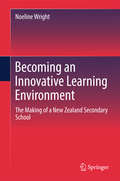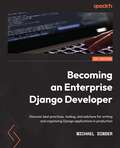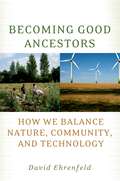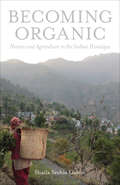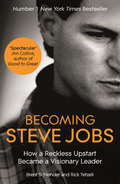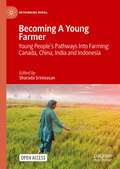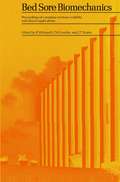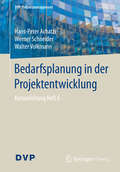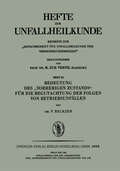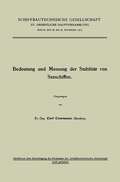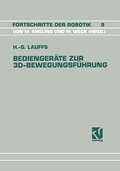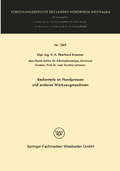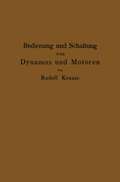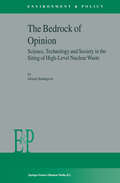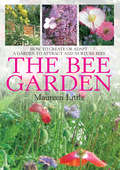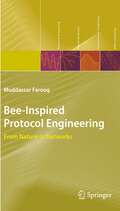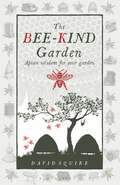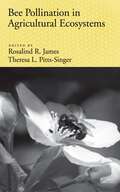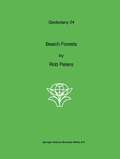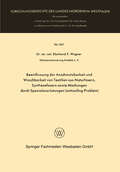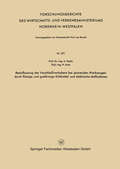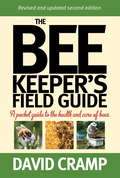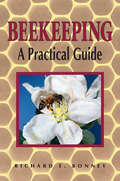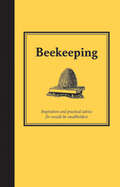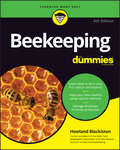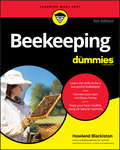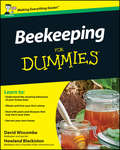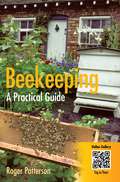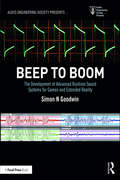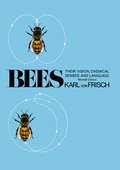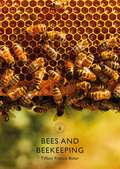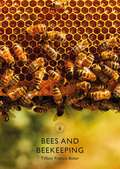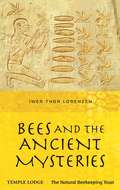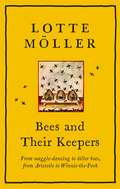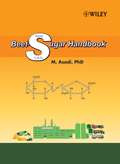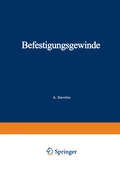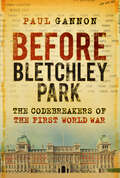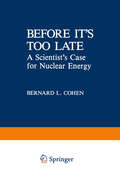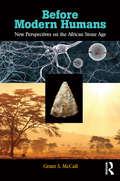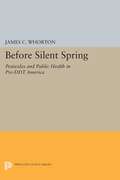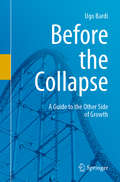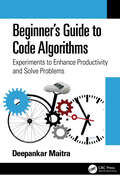- Table View
- List View
Becoming an Innovative Learning Environment: The Making of a New Zealand Secondary School
by Noeline WrightThis book traces how a new school, physically designed as a modern learning environment, has come into being in New Zealand. A key feature is how it designs its curriculum for future citizens. The book explores how flexible curriculum and assessment options support the provision of a well-balanced, coherent and future-oriented learning programme. It also illustrates how the school is implementing its vision and copes with being different from other schools which understand and embody the New Zealand Curriculum as well as the NCEA qualifications system in more traditional terms. School leaders’, teachers’ and foundation students’ thinking and perspectives about what it’s like to become a new school are highlighted and shed light on what is possible within an evolving education system.
Becoming An Enterprise Django Developer: Discover Best Practices, Tooling, And Solutions For Writing And Organizing Django Applications In Production
by Michael DinderDiscover best practices, tooling, and solutions for writing and organizing Django applications in production
Becoming Good Ancestors: How We Balance Nature, Community, and Technology
by David EhrenfeldA brilliant writer and gifted "big picture" thinker, David Ehrenfeld is one of America's leading conservation biologists. Becoming Good Ancestors unites in a single, up-to-date framework pieces written over two decades, spanning politics, ecology, and culture, and illuminating the forces in modern society that thwart our efforts to solve today's hard questions about society and the environment. The book focuses on our present-day retreat from reality, our alienation from nature, our unthinking acceptance of new technology and rejection of the old, the loss of our ability to discriminate between events we can control and those we cannot, the denial of non-economic values, and the decline of local communities. If we are aware of what we are losing and why we are losing it, the author notes, all of these patterns are reversible. Through down-to-earth examples, ranging from a family canoe trip in the wilderness to the novels of Jane Austen to Chinese turtle and tiger farms, Ehrenfeld shows how we can use what we learn to move ourselves and our society towards a more stable, less frantic, and far more satisfying life, a life in which we are no longer compelled to damage ourselves and our environment, in which our children have a future, and in which fewer species are endangered and more rivers run clean. In the final chapter, he offers a dramatic view of the possibilities inherent in a fusion of the best elements of conservatism and liberalism. Our society has an inherent sense of what is right, says Ehrenfeld, and the creativity and persistence to make good things happen. It is now time to apply our intelligence, guided by our moral judgment, to the very large problems we all face. This book is an important first step.
Becoming Organic: Nature and Agriculture in the Indian Himalaya (Yale Agrarian Studies Series)
by Shaila Seshia GalvinA rich, original study of the social and bureaucratic life of organic quality that challenges assumptions of what organic means Tracing the social and bureaucratic life of organic quality, this book yields new understandings of this fraught concept. Shaila Seshia Galvin examines certified organic agriculture in India’s central Himalayas, revealing how organic is less a material property of land or its produce than a quality produced in discursive, regulatory, and affective registers. Becoming Organic is a nuanced account of development practice in rural India, as it has unfolded through complex relationships forged among state authorities, private corporations, and new agrarian intermediaries.
Becoming Steve Jobs: The evolution of a reckless upstart into a visionary leader
by Brent Schlender Rick TetzeliTHE SUNDAY TIMES AND #1 INTERNATIONAL BESTSELLER - with a new foreword by Silicon Valley legend Marc Andreessen.'For my money, a better book about Jobs than Walter Isaacson's biography' New Yorker'A fascinating reinterpretation of the Steve Jobs story' Sunday TimesWe all think we know who Steve Jobs was, what made him tick, and what made him succeed. Yet the single most important question about him has never been answered. The young, impulsive, egotistical genius was ousted in the mid-80s from the company he founded, exiled from his own kingdom and cast into the wilderness. Yet he returned a decade later to transform the ailing Apple into the most successful company the world had ever seen. How did this reckless upstart transform himself into a visionary business leader? The first comprehensive study of Jobs' career following his dismissal from Apple, written with unparalleled access and insight, BECOMING STEVE JOBS offers a startling new portrait of the most important business figure in modern history. The most intimate biography yet of Jobs, written by the journalist who knew him better than any other, BECOMING STEVE JOBS draws on recently discovered interviews that have never before seen the light of day, and answers for the first time the most pressing questions about what made this legendary business leader such a success.'Brent Schlender and Rick Tetzeli render a spectacular service with this book, giving fresh perspective onSteve Jobs' journey from inspiring but immature entrepreneur into an inspired and mature company-builder. Most important, they capture Jobs' resilience, his refusal to capitulate, his restless drive to stay in the game, his voracious appetite to learn-this, far more than genius, is what made him great.Becoming Steve Jobs gets the focus precisely right: not as a success story, but as a growth story. Riveting, insightful, uplifting-read it and learn!' Jim Collins, author of Good to Great'BECOMING STEVE JOBS is fantastic. After working with Steve for over 25 years, I feel this book captures with great insight the growth and complexity of a truly extraordinary person. I hope that it will be recognized as the definitive history.' Ed Catmull, President, Pixar and Disney Animation
Becoming A Young Farmer: Young People’s Pathways Into Farming: Canada, China, India and Indonesia (Rethinking Rural)
by Sharada SrinivasanThis open access book is based on a multi-country collaborative research project focussing on Canada, China, India, and Indonesia.It responds directly and concretely to concerns about the generational sustainability of smallholder farming worldwide– reflected in the current UN Decade of Family Farming. Drawing on research that asks how (some) young people continue to pursue a (future) livelihood in farming, the book uses the life-course perspective and privileges voices of young farmers to show that movement away from farming such as time spent in education, migration and non-farm work does not exclude eventual farming futures.The book will be of interest to scholars and students of agrarian studies, anthropology, development studies, gender studies, human geography, rural sociology, and youth studies.
Bedarfsgerechte Aktuierung eines CVT-Getriebes (Wissenschaftliche Reihe Fahrzeugtechnik Universität Stuttgart)
by Peter MuschPeter Musch stellt zwei verschiedene Konzepte zur bedarfsgerechten Aktuierung von CVT-Getrieben vor. Dabei werden verschiedene Betriebsstrategien der Konzepte und ihr Einfluss auf den Getriebewirkungsgrad mittels validierten Simulationsmodellen untersucht. Auslegung und Konstruktion der einzelnen Komponenten werden detailliert beschrieben und Ergebnisse der Prüfstandsversuche vorgestellt. Die Reduzierung der Aktuierungsenergie kann durch den verbesserten Wirkungsgrad so einen signifikanten Beitrag zum verminderten Flottenverbrauch leisten. Zudem ermöglichen die Konzepte die Realisierung von Hybridfunktionen wie Stopp-Start und Segel.
Bedarfsplanung in der Projektentwicklung: Kurzanleitung Heft 6 (DVP Projektmanagement)
by Hans-Peter Achatzi Werner Schneider Walter VolkmannDas Buch ist ein kompakter Leitfaden zur schrittweisen Erarbeitung der Bedarfsplanung von Hochbauaufgaben. Großprojekte stehen durch Budget- und Terminüberschreitungen zu Recht in der Kritik der Öffentlichkeit. Doch sie sind nur die Spitze des Eisbergs. Auch bei weniger spektakulären Projekten werden Ziele immer wieder verfehlt. Oft werden sie teurer, später fertig und erreichen nicht die erwartete Qualität. Die Fachwelt ist sich einig, dass die entscheidenden Fehler in der ersten Phase eines Projektes gemacht werden, und zwar in der Erarbeitung und Abstimmung der qualitativen und quantitativen Anforderungen. Auch die vom Bundesministerium für Verkehr und digitale Infrastruktur einberufene „Reformkommission Bau von Großprojekten“ hebt die Bedeutung der ersten Schritte in einem Bauprojekt hervor.
Bedeutung der physikalischen und chemischen Eigenschaften von SM-Schlacke für eine Verwendung im Straßenbau (Forschungsberichte des Landes Nordrhein-Westfalen)
by Hans-Ernst SchwieteBedeutung des „Vorherigen Zustands“ für die Begutachtung der Folgen von Betriebsunfällen (Hefte zur Unfallheilkunde)
by P. ReckzehDieser Buchtitel ist Teil des Digitalisierungsprojekts Springer Book Archives mit Publikationen, die seit den Anfängen des Verlags von 1842 erschienen sind. Der Verlag stellt mit diesem Archiv Quellen für die historische wie auch die disziplingeschichtliche Forschung zur Verfügung, die jeweils im historischen Kontext betrachtet werden müssen. Dieser Titel erschien in der Zeit vor 1945 und wird daher in seiner zeittypischen politisch-ideologischen Ausrichtung vom Verlag nicht beworben.
Bedeutung und Messung der Stabilität von Seeschiffen
by Carl CommentzDieser Buchtitel ist Teil des Digitalisierungsprojekts Springer Book Archives mit Publikationen, die seit den Anfängen des Verlags von 1842 erschienen sind. Der Verlag stellt mit diesem Archiv Quellen für die historische wie auch die disziplingeschichtliche Forschung zur Verfügung, die jeweils im historischen Kontext betrachtet werden müssen. Dieser Titel erschien in der Zeit vor 1945 und wird daher in seiner zeittypischen politisch-ideologischen Ausrichtung vom Verlag nicht beworben.
Bediengeräte zur 3D-Bewegungsführung: Ein Beitrag zur effizienten Roboterprogrammierung (Fortschritte der Robotik #9)
by Hans-Georg LauffsBedienteile an Handpressen und anderen Werkzeugmaschinen (Forschungsberichte des Landes Nordrhein-Westfalen #1269)
by Henning WodeÜber die zweckmäßige Art und günstige räumliche Anordnung von Bedienteilen - wie Handräder, Kurbeln und Hebel-gibt es eine umfangreiche Literatur. Sie ist jedoch fast ausnahmslos beschränkt auf folgende Anwendungsfälle : 1. a) Einstellen eines mit dem Bedienteil gekoppelten Zeigers auf eine gewünschte Lage. b) Nachfahren einer sich bewegenden Marke mit einem Zeiger, der mit dem Bedienteil gekoppelt ist. c) Fälle a) und b) jeweils bei einer Teil- oder vollen Umdrehung oder bei meh reren Umdrehungen des Bedienteils ; bei unterschiedlichen Drehwider ständen. 2. a) Einleitung eines möglichst großen Energiebetrages in das Bedienteil bei einer Umdrehung oder mehreren aufeinanderfolgenden Umdrehungen des Bedienteiles. b) Einleiten eines möglichst großen statischen Drehmomentes oder einer mög lichst großen Kraft in das ganz oder nahezu feststehende Bedienteil. Anscheinend fehlen aber noch Untersuchungen über die zweckmäßige Art und Lage von Bedienteilen, an denen vom Menschen Arbeit geleistet werden soll, in 0 dem er sie um weniger als 360 wiederholt gegen einen Arbeitswiderstand hin bewegt und unbelastet zurückbewegt. Da solche Arbeitsbedingungen in der Praxis häufig vorkommen - wie u. a. in diesem Bericht nachgewiesen wird -, ist eine Untersuchung hierüber angebracht. Um Klarheit für den folgenden Bericht zu schaffen, müssen zunächst einige De finitionen gegeben werden: »Handpresse« ist eine Presse, deren für den Arbeitsvorgang notwendige Energie vom Menschen über seine Hand in sie eingeleitet wird. Die Energiezufuhr durch den Menschen erfolgt über das »Bedienteil« : »Bedienteil« ist das Bauteil, über das ein Mensch auf eine Vorrichtung die für die Arbeitsaufgabe nötige Energie überträgt.
Bedienung und Schaltung von Dynamos und Motoren sowie für kleine Anlagen ohne und mit Akkumulatoren
by Rudolf KrauseThe Bedrock of Opinion: Science, Technology and Society in the Siting of High-Level Nuclear Waste (Environment & Policy #32)
by G. SundqvistWhen did man discover nuclear waste? To answer this question, we first have to ask if nuclear waste really is something that could be called a scientific discovery, such as might deserve a Nobel Prize in physics. In early writings within nuclear energy research radioactive waste appears to be a neglected issue, a story never told. Nuclear waste first seems to appear when a public debate arose about public health risks of nuclear power in the late 1960s and early 70s. In nuclear physics, consensus was established at an early stage about the understanding of the splitting of uranium nuclei. The fission products were identified and their chains of disintegration and radioactivity soon were well established facts among the involved scientists, as was an awareness of the risks, for example the strong radioactivity of strontium and iodine, and the poisonous effects of plutonium. However, the by-products were never, either in part or in total, called or perceived as waste, just as fission by-products. How and where to dispose of the by-products were questions that were never asked by the pioneers of nuclear physics.
The Bee Garden: How to Create or Adapt a Garden to Attract and Nurture Bees
by Maureen LittleBees play a vital and irreplaceable role in pollinating our flowers, fruits and vegetables. The more bees in your garden the healthier, more productive and more pleasant a place it will be. Yet bees are declining rapidly and many people, even if they do not wish to keep bees themselves, are asking what can be done on an individual basis to help the bee. This book is a response to that request. It will demonstrate in one accessible volume how each of us can play our part in providing a bee-friendly environment, no matter how much gardening space and/or time we may have. It includes: * How bees forage, what bees you can expect to find in your garden and what plants are best for them. * Why honey bees are so important; what they need to thrive and how they detect and access those requirements; and what varieties of plants are best suited to provide those needs. * How the gardener can offer and maintain a bee-friendly garden, followed by a season-by-season account of what beefriendly plants are in flower and when, and what jobs the gardener can be doing during these times to help bees thrive. * A gazetteer of selected bee-friendly plants, arranged by type of plant in seasonal sub-sections. * Illustrative, practical planting plans, including a culinary herb garden, a potager, a wild flower garden, and a 3 seasons traditional border.
Bee-Inspired Protocol Engineering: From Nature to Networks (Natural Computing Series)
by Muddassar FarooqHoney bee colonies demonstrate robust adaptive efficient agent-based communications and task allocations without centralized controls – desirable features in network design. This book introduces a multipath routing algorithm for packet-switched telecommunication networks based on techniques observed in bee colonies. The algorithm, BeeHive, is dynamic, simple, efficient, robust and flexible, and it represents an important step towards intelligent networks that optimally manage resources. The author guides the reader in a survey of nature-inspired routing protocols and communication techniques observed in insect colonies. He then offers the design of a scalable framework for nature-inspired routing algorithms, and he examines a practical application using real networks of Linux routers. He also utilizes formal techniques to analytically model the performance of nature-inspired routing algorithms. In the last chapters of the book, he introduces an immune-inspired security framework for nature-inspired algorithms, and uses the wisdom of the hive for routing in ad hoc and sensor networks. Finally, the author provides a comprehensive bibliography to serve as a reference for nature-inspired solutions to networking problems. This book bridges the gap between natural computing and computer networking. What sets this book apart from other texts on this subject is its natural engineering approach in which the challenges and objectives of a real-world system are identified before its solution, nature-inspired or otherwise, is discussed. This balanced exposition of the book makes it equally suitable for telecommunication network designers and theorists, and computer science researchers engaged with artificial intelligence, agents, and nature-inspired techniques.
The Bee-Kind Garden: Apian wisdom for your garden (Wise Words #1)
by David SquireThe lives of bees are interwoven with our own, but how much do you know about them?Which scents do bees prefer? How do bees transport pollen? How far can bees fly? Do specific colours attract bees? Do bees prefer native flowers? Bees are a delight to see in the garden on warm summer days, buzzing as they flit from flower to flower. They are also vital for the future of the planet and without their dedicated pollinating skills, many crops would eventually fail. Then there is honey – a near-miraculous elixir that in earlier generations was an integral part of life as a sweetener and food preserver. It can be fermented with water and yeast to create mead, a drink that has been enjoyed for thousands of years. The Bee-Kind Garden reveals the many facets of the lives of bees, including their hives, flight patterns and defence. It is filled with helpful information on important topics such as which flowers are best for attracting bees to your garden, beekeeping equipment and guidance for extracting honey as well as the art of talking to bees. It also celebrates the charming proverbs, limericks and verse bees have inspired.This delightfully illustrated book is a homage to bees and to ensuring that they continue to live in harmony with humans in bee-friendly gardens.
Bee Pollination in Agricultural Ecosystems
by Rosalind James Theresa L. Pitts-SingerFor many agricultural crops, bees play a vital role as pollinators, and this book discusses the interplay among bees, agriculture, and the environment. Although honey bees are well recognized as pollinators, managed bumble bees and solitary bees are also critical for the successful pollination of certain crops, while wild bees provide a free service. As bees liberally pass pollen from one plant to the next, they also impact the broader ecosystem, and not always to the benefit of humankind. Bees can enhance the unintentional spread of genes from genetically engineered plants, and may increase the spread of invasive weeds. Conversely, genetically engineered plants can impact pollinators, and invasive weeds can supply new sources of food for these insects. Bees' flower-visiting activities also can be exploited to help spread biological control agents that control crop pests, and they are important for native plant reproduction. Managing bees for pollination is complex and the factors that must be taken into consideration are treated here, including bee natural history, physiology, pathology, and behavior. Furthermore, transporting bees from native ranges to new areas for pollination services can be controversial, and needs to be done only after assuring that it will not disrupt various ecosystems. Even though bees are small, unobtrusive creatures, they play large roles in the ecosystem. The connection between bees and humankind also is symbolic of a broader interconnection between humans and the natural world.
Beeinflussung der Anschmutzbarkeit und Waschbarkeit von Textilien aus Naturfasern, Synthesefasern sowie Mischungen durch Spezialausrüstungen (Forschungsberichte des Landes Nordrhein-Westfalen #1411)
by Eberhard Frithjof WagnerBeeinflussung des Verschleißverhaltens bei spanenden Werkzeugen durch flüssige und gasförmige Kühlmittel und elektrische Maßnahmen (Forschungsberichte des Wirtschafts- und Verkehrsministeriums Nordrhein-Westfalen #271)
by Herwart OpitzThe Beekeeper's Field Guide: A Pocket Guide to the Health and Care of Bees
by David CrampThis guide is a diagnostic tool and an aide memoire for the hobbyist and for the professional beekeeper, who may know what to do but will at times need the information close to hand. It includes: - A troubleshooting guide to problems with colonies and queen bees - A guide to the field diagnosis, treatment and control of diseases - Seasonal apiary management checklists - Hive product harvesting checklists - The beekeeper's ready reckoner The second and revised edition of this fully illustrated and handy guide to the apiary brings the science and craft of beekeeping to beekeepers right where they need it - in the field with the bees.Contents: Preface; List of figures; List of photographs; List of tables; Picture credits; Introduction; Part A: Setting up an Apiary; Part B: Crops, Trees and Plants for Bees; Part C: Troubleshooting Guide to Field Operations; Part D: Swarm Prevention and Control; Part E: Queen Bees; Part F: Honey Harvest Procedures; Part G: Hive Checks; Part H: Pests and Diseases; Part I: A Beekeeper's Ready-reckoner; Part J.
Beekeeping: A Practical Guide
by Richard E. BonneyKeep your own bees and enjoy delicious golden honey from your own backyard. With his respect and admiration for bees evident on every page, Richard E. Bonney describes how to acquire bees, manage a hive, prevent and treat diseases, and extract a crop of honey. Enthusiastic beekeepers of every stripe and experience level will benefit from Bonney&’s astonishing knowledge of the craft — from beekeeping history and honeybee biology to the complex social structure of the hive.
Beekeeping: Inspiration And Practical Advice For Would-be Smallholders (Countryside Ser.)
by Andrew T. DaviesIt's no shock that the beekeeping trend is steadily on the rise. These fascinating and beautiful insects can be kept anywhere, whether your garden is a large country plot or an urban rooftop terrace. What's more, there's no sting in this tale: bees are a source of delight for honey lovers, hay-fever sufferers and gardeners alike.
Beekeeping For Dummies
by Howland BlackistonEverything you need to 'bee' a successful backyard beekeeper If you've ever thought about becoming a backyard beekeeper—or have already tried a hand at it and want to be better one—then this is the book for you! In Beekeeping for Dummies, 4th Edition you'll find everything you need to know in order to start your own colony, including how to assemble and maintain beehives, handle every phase of honey production, purchase and use all the latest tools, and what to do beyond your first season. This hands-on guide provides all the tools, tips, tricks, and techniques needed to become a real backyard beekeeper. You'll learn to identify the queen from her workers and drones, properly open and close the hive, distinguish one type of honey from another, and preserve your colony if disaster should strike. Keep bees on a small urban rooftop or in a large country yard Assemble your own hive and sustain it for years to come Safely inspect and manage your colony Harvest and sell your own honey Becoming a backyard beekeeper isn't as hard as people think—and with this hands-on guide, you'll be able to create one honey of a colony that will have the neighbors buzzing.
Beekeeping For Dummies
by Howland BlackistonEverything you need to 'bee' a successful backyard beekeeper If you've ever thought about becoming a backyard beekeeper—or have already tried a hand at it and want to be better one—then this is the book for you! In Beekeeping for Dummies, 4th Edition you'll find everything you need to know in order to start your own colony, including how to assemble and maintain beehives, handle every phase of honey production, purchase and use all the latest tools, and what to do beyond your first season. This hands-on guide provides all the tools, tips, tricks, and techniques needed to become a real backyard beekeeper. You'll learn to identify the queen from her workers and drones, properly open and close the hive, distinguish one type of honey from another, and preserve your colony if disaster should strike. Keep bees on a small urban rooftop or in a large country yard Assemble your own hive and sustain it for years to come Safely inspect and manage your colony Harvest and sell your own honey Becoming a backyard beekeeper isn't as hard as people think—and with this hands-on guide, you'll be able to create one honey of a colony that will have the neighbors buzzing.
Beekeeping For Dummies: 4th Edition
by Howland BlackistonThe single best and most comprehensive guide for prospective, new and experienced hobbyist beekeepers Beekeeping For Dummies, 5th Edition, is one of the most popular titles in the For Dummies series available today. Including the latest information regarding every aspect of backyard beekeeping and honey production, this book describes how to get started, how to care for and safely handle bees, and how to maintain healthy and productive colonies. This book is loaded with up-to-date, practical examples and helpful illustrations of proven techniques and strategies for both new and seasoned hobbyist beekeepers. Some of the updates for this brand-new edition include: New information regarding the critical role that nutrition plays in the health and productivity of your bees News about the latest beekeeping products, medications, and all-natural remedies Information regarding dozens of helpful beekeeping resources Redeemable coupons from beekeeping suppliers that save the reader money Beekeeping For Dummies embodies the straightforward and simple approach made famous by the For Dummies series. Each and every reader will benefit from its accessible and approachable take on beekeeping.
Beekeeping For Dummies
by Howland BlackistonThe single best and most comprehensive guide for prospective, new and experienced hobbyist beekeepers Beekeeping For Dummies, 5th Edition, is one of the most popular titles in the For Dummies series available today. Including the latest information regarding every aspect of backyard beekeeping and honey production, this book describes how to get started, how to care for and safely handle bees, and how to maintain healthy and productive colonies. This book is loaded with up-to-date, practical examples and helpful illustrations of proven techniques and strategies for both new and seasoned hobbyist beekeepers. Some of the updates for this brand-new edition include: New information regarding the critical role that nutrition plays in the health and productivity of your bees News about the latest beekeeping products, medications, and all-natural remedies Information regarding dozens of helpful beekeeping resources Redeemable coupons from beekeeping suppliers that save the reader money Beekeeping For Dummies embodies the straightforward and simple approach made famous by the For Dummies series. Each and every reader will benefit from its accessible and approachable take on beekeeping.
Beekeeping For Dummies: 4th Edition
by David Wiscombe Howland BlackistonThe fast and easy way to start and maintain a hive Beekeeping For Dummies is a practical, step-by-step beginner's guide to beekeeping. It gives you plain-English guidance on everything you need to know to start your own beehive, from buying the right equipment, sourcing bees, and locating your hive to maintaining a healthy colony and harvesting honey. Plus, you'll get the latest information on the causes and effects of bee disease, colony collapse disorder, and the impact the sudden disappearance of the honeybee has on our environment and economy. Here, you'll get trusted information on beekeeping in the UK, specifically written to address climate, buying equipment, locating hives, the local impact of colony collapse disorder and ways to avoid or minimise the risk to your hive, seasonal beekeeping tasks, local beekeeping associations, and updated content on urban beekeeping. Understand the anatomy of your bees Learn techniques and tips for harvesting, bottling, packaging, and selling honey Discover the benefits of beekeeping Learn techniques on obtaining and hiving your bees If you're a beginner beekeeper, taking a beekeeping course, or just have an interest in the plight of the honeybee, Beekeeping For Dummies has you covered!
Beekeeping For Dummies
by David Wiscombe Howland BlackistonThe fast and easy way to start and maintain a hive Beekeeping For Dummies is a practical, step-by-step beginner's guide to beekeeping. It gives you plain-English guidance on everything you need to know to start your own beehive, from buying the right equipment, sourcing bees, and locating your hive to maintaining a healthy colony and harvesting honey. Plus, you'll get the latest information on the causes and effects of bee disease, colony collapse disorder, and the impact the sudden disappearance of the honeybee has on our environment and economy. Here, you'll get trusted information on beekeeping in the UK, specifically written to address climate, buying equipment, locating hives, the local impact of colony collapse disorder and ways to avoid or minimise the risk to your hive, seasonal beekeeping tasks, local beekeeping associations, and updated content on urban beekeeping. Understand the anatomy of your bees Learn techniques and tips for harvesting, bottling, packaging, and selling honey Discover the benefits of beekeeping Learn techniques on obtaining and hiving your bees If you're a beginner beekeeper, taking a beekeeping course, or just have an interest in the plight of the honeybee, Beekeeping For Dummies has you covered!
Beekeeping - A Practical Guide: A Practical Guide
by Roger PattersonA practical book for new beekeepers and those interested in keeping their own bees, explaining everything they need to know to get started. It also covers how to make your garden attractive for bees. Published to coincide with the biggest beginners' day for beekeeping which takes place in February each year.
Beep to Boom: The Development of Advanced Runtime Sound Systems for Games and Extended Reality (Audio Engineering Society Presents)
by Simon N GoodwinDrawing on decades of experience, Beep to Boom: The Development of Advanced Runtime Sound Systems for Games and Extended Reality is a rigorous, comprehensive guide to interactive audio runtime systems. Packed with practical examples and insights, the book explains each component of these complex geometries of sound. Using practical, lowest-common-denominator techniques, Goodwin covers soundfield creation across a range of platforms from phones to VR gaming consoles. Whether creating an audio system from scratch or building on existing frameworks, the book also explains costs, benefits and priorities. In the dynamic simulated world of games and extended reality, interactive audio can now consider every intricacy of real-world sound. This book explains how and why to tame it enjoyably.
Beep to Boom: The Development of Advanced Runtime Sound Systems for Games and Extended Reality (Audio Engineering Society Presents)
by Simon N GoodwinDrawing on decades of experience, Beep to Boom: The Development of Advanced Runtime Sound Systems for Games and Extended Reality is a rigorous, comprehensive guide to interactive audio runtime systems. Packed with practical examples and insights, the book explains each component of these complex geometries of sound. Using practical, lowest-common-denominator techniques, Goodwin covers soundfield creation across a range of platforms from phones to VR gaming consoles. Whether creating an audio system from scratch or building on existing frameworks, the book also explains costs, benefits and priorities. In the dynamic simulated world of games and extended reality, interactive audio can now consider every intricacy of real-world sound. This book explains how and why to tame it enjoyably.
Bees: Their Vision, Chemical Senses, and Language
by Karl von FrischOver half a century of brilliant scientific detective work, the Nobel Prize-winning biologist Karl von Frisch learned how the world, looks, smells, and tastes to a bee. More significantly, he discovered their dance language and their ability to use the sun as a compass. Intended to serve as an accessible introduction to one of the most fascinating areas of biology, Bees (first published in 1950 and revised in 1971), reported the startling results of his ingenious and revolutionary experiments with honeybees. In his revisions, von Frisch updated his discussion about the phylogenetic origin of the language of bees and also demonstrated that their color sense is greater than had been thought previously. He also took into consideration the electrophysiological experiments and electromicroscopic observations that have supplied more information on how the bee analyzes polarized light to orient itself and how the olfactory organs on the bee's antennae function. Now back in print after more than two decades, this classic and still-accurate account of the behavior patterns and sensory capacities of the honeybee remains a book "written with a simplicity, directness, and charm which all who know him will recognize as characteristic of its author. Any intelligent reader, without scientific training, can enjoy it."—Yale Review
Bees and Beekeeping (Shire Library)
by Tiffany Francis-BakerBees existed long before human beings, but our future is perhaps more reliant upon them than any other species. They pollinate 80 per cent of the world's crops and plants, but how much do we really know about them? Small, clever and mysterious, the honeybee in particular has long been celebrated in human culture as a sacred insect, a symbol of the sun, bridging the gap between our world and the next. They are expert communicators, skilled aviators and natural alchemists, turning fresh nectar into sweet, golden honey. They are also in trouble and need our help. This beautifully illustrated guide explores the honeybee's historic relationship with humans, the basics of beekeeping, and how we can help save the bees' dwindling population.
Bees and Beekeeping (Shire Library)
by Tiffany Francis-BakerBees existed long before human beings, but our future is perhaps more reliant upon them than any other species. They pollinate 80 per cent of the world's crops and plants, but how much do we really know about them? Small, clever and mysterious, the honeybee in particular has long been celebrated in human culture as a sacred insect, a symbol of the sun, bridging the gap between our world and the next. They are expert communicators, skilled aviators and natural alchemists, turning fresh nectar into sweet, golden honey. They are also in trouble and need our help. This beautifully illustrated guide explores the honeybee's historic relationship with humans, the basics of beekeeping, and how we can help save the bees' dwindling population.
Bees and the Ancient Mysteries
by Iwer Thor LorenzenIn an extraordinary exposition, Lorenzen – an expert beekeeper and student of contemporary spiritual science – describes the ‘Logos mysteries’, based at the ancient temple of Artemis in Ephesus, where priestesses were known as ‘Melissas’ (‘honeybees’) and the sacrificial priests were called ‘Essenes’ (or ‘bee-kings’). These cultic mysteries, he says, bore remarkable parallels to the workings of a bee colony – specifically in the relationship between the queen and worker bees to the spiritual ‘group-soul’ of the bees.Lorenzen commences his unique study with a discussion of flowers and insects, exploring their common origins. He then describes the beginnings of the honeybee, its connection with the fig wasp, and the subsequent controlled transformation of the latter that took place in pre-historic mystery-centres. Breeding the honeybee from the fig wasp – a sacred deed performed at consecrated sanctuaries – was part of the ‘Fig-tree mysteries’. The initiates behind this task developed the ability to commune with the bees’ group-soul and to work consciously on the mutual development of the hive and humanity.This concise but rich work features an illuminating foreword by Heidi Herrmann of the Natural Beekeeping Trust as well as a lucid introduction by translator Paul King that explains the anthroposophical concepts employed by Lorenzen in his text.
Bees and Their Keepers: Through the seasons and centuries, from waggle-dancing to killer bees, from Aristotle to Winnie-the-Pooh
by Lotte MöllerA beautifully illustrated and thoroughly engaging cultural history of beekeeping - packed with anecdote, humour and enriching historical detail. The perfect gift."A charming look at the history of beekeeping, from myth and folklore to our practical relationship with bees" Gardens IllustratedBeekeeper and garden historian Lotte Möller explores the activities inside and outside the hive while charting the bees' natural order and habits. With a light touch she uses her encyclopaedic knowledge of the subject to shed light on humanity's understanding of bees and bee lore from antiquity to the present. A humorous debunking of the myths that have held for centuries is matched by a wry exploration of how and when they were replaced by fact. In her travels Möller encounters a trigger-happy Californian beekeeper raging against both killer bees and bee politics, warring beekeepers on the Danish island of Læso, and Brother Adam of Buckfast Abbey, breeder of the Buckfast queen now popular throughout Europe and beyond, as well a host of others as passionate as she about the complex world of apiculture both past and present.Translated from the Swedish by Frank Perry - Sweden's Gardening Book of the Year 2019, shortlisted for the August Prize 2019
Beet-Sugar Handbook
by Mosen AsadiThe first all-in-one reference for the beet-sugar industry Beet-Sugar Handbook is a practical and concise reference for technologists, chemists, farmers, and research personnel involved with the beet-sugar industry. It covers: * Basics of beet-sugar technology * Sugarbeet farming * Sugarbeet processing * Laboratory methods of analysis The book also includes technologies that improve the operation and profitability of the beet-sugar factories, such as: * Juice-softening process * Molasses-softening process * Molasses-desugaring process * Refining cane-raw sugar in a beet-sugar factory The book ends with a review of the following: * Environmental concerns of a beet-sugar factory * Basics of science related to sugar technology * Related tables for use in calculations Written in a conversational, engaging style, the book is user friendly and practical in its presentation of relevant scientific and mathematical concepts for readers without a significant background in these areas. For ease of use, the book highlights important notes, defines technical terms, and presents units in both metric and British systems. Operating problem-solving related to all stations of sugarbeet processing, frequent practical examples, and given material/energy balances are other special features of this book.
Befestigungsgewinde: Gegenüberstellung der DIN-Normen mit der amerikanischen Norm ASA B 1.1–1949
by A. SievrittsBefore Bletchley Park: The Codebreakers of the First World War
by Paul GannonThe story of Bletchley Park’s codebreaking operations in the Second World War is now well known, but its counterparts in the First World War – Room 40 & MI1(b) – remain in the shadows, despite their involvement in and influence on most of the major events of that war. From the First Battle of the Marne, the shelling of Scarborough, the battles of Jutland and the Somme in 1916, to the battles on the Western Front in 1918, the German naval mutiny and the Zimmermann Telegram, this cast of characters – several of them as eccentric as anyone from Bletchley Park in the Second World War – secretly guided the outcome of the ‘Great War’ from the confines of a few smoke-filled rooms. Using hundreds of intercepted and decrypted German military, naval and diplomatic messages, bestselling author Paul Gannon reveals the fascinating story of British codebreaking operations. By drawing on many newly discovered archival documents that challenge misleading stories about Room 40 & MI1(b), he reveals a sophisticated machine in operation.
Before it’s Too Late: A Scientist’s Case for Nuclear Energy
by B.L. CohenI was not invited to write a foreword for this book. Dr. Cohen, knowing my busy schedule, would have considered such a request to be an imposition. I volunteered to do so in part to acknowledge my gratitude to him for having been a constant source of reference materials as I have turned my attention increasingly to informing both lay and scientific audiences concerning the biologic effects of low-level ionizing radiation. My primary reason for vol unteering, however, is to point to the importance of such a book for public education at a time when the media, in collaboration with a variety of activist groups, have developed among the people an almost phobic fear of radiation at any level. I take issue with the words of another Nobel laureate, George Wald, who states regularly "Every dose is an overdose. '" This philosophy has re sulted in women refusing mammography for the detection of breast cancer even though this methodology is the most sensitive for detection of such cancers in the early, curable stage, and even though, at present, breast cancer is the leading cause of cancer deaths among women. It has led a Westchester County, New York legislator to state proudly in the New York Times that he v vi I FOREWORD had introduced legislation that would bar all radioactivity from the county's roads.
Before Modern Humans: New Perspectives on the African Stone Age
by Grant S. McCallThis fascinating volume, assessing Lower and Middle Pleistocene African prehistory, argues that the onset of the Middle Stone Age marks the origins of landscape use patterns resembling those of modern human foragers. Inaugurating a paradigm shift in our understanding of modern human behavior, Grant McCall argues that this transition—related to the origins of “home base” residential site use—occurred in mosaic fashion over the course of hundreds of thousands of years. He concludes by proposing a model of brain evolution driven by increasing subsistence diversity and intensity against the backdrop of larger populations and Pleistocene environmental unpredictability. McCall argues that human brain size did not arise to support the complex patterns of social behavior that pervade our lives today, but instead large human brains were co-opted for these purposes relatively late in prehistory, accounting for the striking archaeological record of the Upper Pleistocene.
Before Modern Humans: New Perspectives on the African Stone Age
by Grant S. McCallThis fascinating volume, assessing Lower and Middle Pleistocene African prehistory, argues that the onset of the Middle Stone Age marks the origins of landscape use patterns resembling those of modern human foragers. Inaugurating a paradigm shift in our understanding of modern human behavior, Grant McCall argues that this transition—related to the origins of “home base” residential site use—occurred in mosaic fashion over the course of hundreds of thousands of years. He concludes by proposing a model of brain evolution driven by increasing subsistence diversity and intensity against the backdrop of larger populations and Pleistocene environmental unpredictability. McCall argues that human brain size did not arise to support the complex patterns of social behavior that pervade our lives today, but instead large human brains were co-opted for these purposes relatively late in prehistory, accounting for the striking archaeological record of the Upper Pleistocene.
Before Silent Spring: Pesticides and Public Health in Pre-DDT America (PDF)
by James C. WhortonModern consumers are well aware that the food they eat is tainted by pesticidal residues; they are less aware that their great-grandparents faced the same hazard. James C. Whorton's history of this public health menace emphasizes that insecticides have been contaminating produce since the introduction of chemical pesticides in the 1860s.The book examines the period before the publication of Rachel Carson's famous Silent Spring, tracing the origins of the residue problem and exploring the complicated network of interest groups that formed around the issue. The author shows how economic necessities, technological limitations, and pressures on regulatory agencies have brought us to "our present dilemma of seemingly having to poison our food in order to protect it." In Part I, the agricultural and medical literature of the past century is used to analyze the emergence by 1920 of a public health danger of serious proportions. Part II draws heavily on the unpublished records of the Food and Drug Administration to document how the ineffective handling of this danger established precedents for present pesticide abuses.Originally published in 1975.The Princeton Legacy Library uses the latest print-on-demand technology to again make available previously out-of-print books from the distinguished backlist of Princeton University Press. These editions preserve the original texts of these important books while presenting them in durable paperback and hardcover editions. The goal of the Princeton Legacy Library is to vastly increase access to the rich scholarly heritage found in the thousands of books published by Princeton University Press since its founding in 1905.
Before the Collapse: A Guide to the Other Side of Growth
by Ugo BardiNobody has to tell you that when things go bad, they go bad quickly and seemingly in bunches. Complicated structures like buildings or bridges are slow and laborious to build but, with a design flaw or enough explosive energy, take only seconds to collapse. This fate can befall a company, the stock market, or your house or town after a natural disaster, and the metaphor extends to economies, governments, and even whole societies. As we proceed blindly and incrementally in one direction or another, collapse often takes us by surprise. We step over what you will come to know as a “Seneca cliff”, which is named after the ancient Roman philosopher, Lucius Annaeus Seneca, who was the first to observe the ubiquitous truth that growth is slow but ruin is rapid. Modern science, like ancient philosophy, tell us that collapse is not a bug; it is a feature of the universe. Understanding this reality will help you to see and navigate the Seneca cliffs of life, or what Malcolm Gladwell called “tipping points.” Efforts to stave off collapse often mean that the cliff will be even steeper when you step over it. But the good news is that what looks to you like a collapse may be nothing more than the passage to a new condition that is better than the old.This book gives deeper meaning to familiar adages such as “it’s a house of cards”, “let nature take its course”, “reach a tipping point”, or the popular Silicon Valley expression, “fail fast, fail often.” As the old Roman philosopher noted, “nothing that exists today is not the result of a past collapse”, and this is the basis of what we call “The Seneca Strategy.” This engaging and insightful book will help you to use the Seneca Strategy to face failure and collapse at all scales, to understand why change may be inevitable, and to navigate the swirl of events that frequently threaten your balance and happiness. You will learn:How ancient philosophy and modern science agree that failure and collapse are normal features of the universePrinciples that help us manage, rather than be managed by, the biggest challenges of our lives and times Why technological progress may not prevent economic or societal collapseWhy the best strategy to oppose failure is not to resist at all costsHow you can “rebound” after collapse, to do better than before, and to avoid the same mistakes.
Begin Again
by Oliver JeffersA powerful, thoughtful and bold comment on humanity and its future from one of today’s most thought-provoking artists.
Beginner's Guide to Code Algorithms: Experiments to Enhance Productivity and Solve Problems
by Deepankar MaitraDo you have creative ideas that you wish you could transform into code?Do you want to boost your problem solving and logic skills?Do you want to enhance your career by adopting an algorithmic mindset?In our increasingly digital world, coding is an essential skill. Communicating an algorithm to a machine to perform a set of tasks is vital. Beginner’s Guide to Code Algorithms: Experiments to Enhance Productivity and Solve Problems written by Deepankar Maitra teaches you how to think like a programmer. The author unravels the secret behind writing code – building a good algorithm. Algorithmic thinking leads to asking the right question and enables a shift from issue resolution to value creation. Having this mindset will make you more marketable to employers. This book takes you on a problem-solving journey to expand your mind and increase your willingness to experiment with code. You will: Learn the art of building an algorithm through hands-on exercises Understand how to develop code for inspiring productivity concepts Build a mentality of developing algorithms to solve problems Develop, test, review, and improve code through guided experimentation This book is designed to develop a culture of logical thinking through intellectual stimulation. It will benefit students and teachers of programming, business professionals, as well as experienced users of Microsoft Excel who wish to become proficient with macros.
